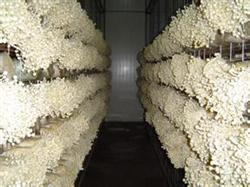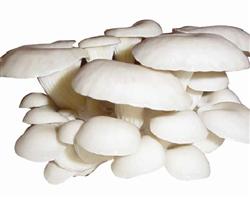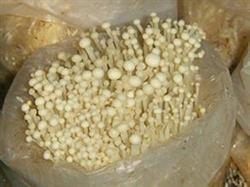Measures to promote mycelium growth of Pleurotus ostreatus in spring

The external temperature is relatively low in spring, and the mycelium growth of Pleurotus ostreatus is slow, which affects the yield and benefit. in order to solve this problem, the following measures should be taken: 1. Increase the amount of lime to 5% when mixing. The pH value of the mixed material is between 8 and 9, which can inhibit the growth of miscellaneous bacteria and improve the growth rate of mycelium. 2. Direct bagging: after the raw meal is mixed, it is directly bagged without fermentation, so that the culture material in the bag produces more heat, thus speeding up the speed of bacteria generation. 3. Increase the amount of inoculation: appropriately increase the amount of seed used when bagging, and change the three-layer inoculation to four-layer inoculation. The middle fungus should also be enlarged appropriately, and the fungus should be close to the plastic bag, with a circle of 4-5 pieces. The seed blocks at both ends of the bag can be slightly smaller, 6-7 pieces at each end. After piercing the mouth, use a stick with a diameter of 10 to 12 mm to pierce 4 to 5 air holes at each end of the bag, each with a depth of half the length of the bag, so that the mycelium in the bag can grow with enough oxygen. By using this technology, the inoculation time of bacteria bag can be shortened from 30 to 35 days to 15 to 20 days, and the mycelium is stout and white, and the contamination rate can be controlled below 2%. 4. Pile up the bacteria: after moving the bag into the mushroom shed, put the bag on top of each other and put it 6-8 stories high, cover with grass to keep warm. The production practice shows that the higher the stack of the bacterial bag is, the closer the stack distance is, and the higher the interreactor temperature is. By using this code stacking method, the temperature of the bacterial bag can be raised to 23-28 ℃. The mycelium grows fastest at this temperature. 5. Raise the temperature of the greenhouse: the mushroom shed is covered with semi-no dripping film and grass mulch. As long as there is the sun during the day, all the grass on the roof can be pulled open, and the temperature in the shed can reach 10: 23 ℃ by relying on the sun.
- Prev

Technology of interplanting Pleurotus ostreatus with Cotton
Pleurotus ostreatus can be cultivated all the year round, but the benefit of Pleurotus ostreatus cultivated in high temperature season is high. Reasons: first, the high temperature in summer, the difficulty of planting technology, diseases and insect pests are easy to occur, which often lead to cultivation failure. Second, the total cultivation area of Pleurotus ostreatus decreased in summer, and the total output was small, resulting in a shortage of fresh Pleurotus ostreatus in the market and a rise in prices. Root.
- Next

Pollution-free high-quality cultivation of Flammulina velutipes
Flammulina velutipes, also known as Flammulina velutipes, Flammulina velutipes, gets its name because its fruiting body shape is mainly generated and golden in winter. The cultivation of Flammulina velutipes has a long history and there are many methods. The new practical bagging technology with high economic benefit and simple method is introduced as follows. First, culture material configuration 1, sawdust (.
Related
- Fuxing push coffee new agricultural production and marketing class: lack of small-scale processing plants
- Jujube rice field leisure farm deep ploughing Yilan for five years to create a space for organic food and play
- Nongyu Farm-A trial of organic papaya for brave women with advanced technology
- Four points for attention in the prevention and control of diseases and insect pests of edible fungi
- How to add nutrient solution to Edible Fungi
- Is there any good way to control edible fungus mites?
- Open Inoculation Technology of Edible Fungi
- Is there any clever way to use fertilizer for edible fungus in winter?
- What agents are used to kill the pathogens of edible fungi in the mushroom shed?
- Rapid drying of Edible Fungi

